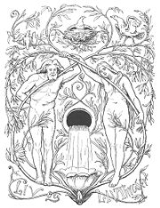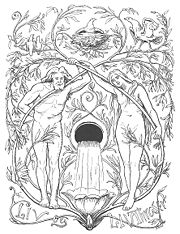
Líf and Lífthrasir
Encyclopedia

Norse mythology
Norse mythology, a subset of Germanic mythology, is the overall term for the myths, legends and beliefs about supernatural beings of Norse pagans. It flourished prior to the Christianization of Scandinavia, during the Early Middle Ages, and passed into Nordic folklore, with some aspects surviving...
, Líf (Old Norse
Old Norse
Old Norse is a North Germanic language that was spoken by inhabitants of Scandinavia and inhabitants of their overseas settlements during the Viking Age, until about 1300....
"life") and Lífþrasir (Old Norse "the one striving after life" or "thriving remnant")—male and female respectively—are two humans who are foretold to survive the events of Ragnarök
Ragnarök
In Norse mythology, Ragnarök is a series of future events, including a great battle foretold to ultimately result in the death of a number of major figures , the occurrence of various natural disasters, and the subsequent submersion of the world in water...
by hiding in Hoddmímis holt, and after the flames have sated, to repopulate the newly risen and fertile world. Líf and Lífthrasir are attested in the Poetic Edda
Poetic Edda
The Poetic Edda is a collection of Old Norse poems primarily preserved in the Icelandic mediaeval manuscript Codex Regius. Along with Snorri Sturluson's Prose Edda, the Poetic Edda is the most important extant source on Norse mythology and Germanic heroic legends, and from the early 19th century...
, compiled in the 13th century from earlier traditional sources, and the Prose Edda
Prose Edda
The Prose Edda, also known as the Younger Edda, Snorri's Edda or simply Edda, is an Icelandic collection of four sections interspersed with excerpts from earlier skaldic and Eddic poetry containing tales from Nordic mythology...
, written in the 13th century by Snorri Sturluson
Snorri Sturluson
Snorri Sturluson was an Icelandic historian, poet, and politician. He was twice elected lawspeaker at the Icelandic parliament, the Althing...
. Scholarly theories have been proposed about the underlying meaning and origins of the two.
Attestations
In the poem VafþrúðnismálVafþrúðnismál
In Norse mythology, Vafþrúðnismál is the third poem in the Poetic Edda. It is a conversation in verse form conducted initially between the Æsir Odin and Frigg, and subsequently between Odin and the giant Vafþrúðnir...
, collected in the Poetic Edda, the god Odin
Odin
Odin is a major god in Norse mythology and the ruler of Asgard. Homologous with the Anglo-Saxon "Wōden" and the Old High German "Wotan", the name is descended from Proto-Germanic "*Wodanaz" or "*Wōđanaz"....
poses a question to the jötunn Vafþrúðnir
Vafþrúðnir
Vafþrúðnir is a wise jötunn in Norse mythology. In the Poetic Edda poem Vafþrúðnismál, Vafþrúðnir acts as both Odin's host and opponent in a deadly battle of wits, resulting in Vafþrúðnir's defeat....
, asking who among mankind will survive when the winter Fimbulvetr occurs. Vafþrúðnir responds that they will be Líf and Lífþrasir, that the two will have hidden in the wood of Hoddmímis holt, they will consume the morning dew as food, and "from them generations will spring".
In chapter 53 of the Prose Edda book Gylfaginning
Gylfaginning
Gylfaginning, or the Tricking of Gylfi , is the first part of Snorri Sturluson's Prose Edda after Prologue. The Gylfaginning deals with the creation and destruction of the world of the Norse gods, and many other aspects of Norse mythology...
, High
High, Just-As-High, and Third
High, Just-As-High, and Third are three men that respond to questions posed by Gangleri in the Prose Edda book Gylfaginning...
tells Gangleri
Gangleri
Gangleri may refer to:* one of Odin's many nicknames meaning "the wanderer" or "Wayweary"* the name of the ancient Swedish king Gylfi, given while in disguise, as described in the book Gylfaginning collected in the Prose Edda...
(king Gylfi
Gylfi
In Norse mythology, Gylfi, Gylfe, Gylvi, or Gylve was the earliest king in Scandinavia recorded. The traditions on Gylfi deal with how he was tricked by the gods and his relations with the goddess Gefjon.-The creation of Zealand:...
in disguise) that two people, Líf and Lífþrasir, will lie hid in Hoddmímis holt during "Surt's
Surtr
In Norse mythology, Surtr or Surt is an eldjötunn. Surtr is attested in the Poetic Edda, compiled in the 13th century from earlier traditional sources, and the Prose Edda, written in the 13th century by Snorri Sturluson...
fire", and that "from these people there will be descended such a great progeny that the world will be inhabited." The above mentioned stanza of Vafþrúðnismál is then quoted.
Theories
Carolyne Larrington notes that it is nowhere expressly stated what will happen to the world tree YggdrasilYggdrasil
In Norse mythology, Yggdrasil is an immense tree that is central in Norse cosmology. It was said to be the world tree around which the nine worlds existed...
at Ragnarök, points to a connection between Mímir
Mímir
Mímir or Mim is a figure in Norse mythology renowned for his knowledge and wisdom who is beheaded during the Æsir-Vanir War...
and Yggdrasil in the poem Völuspá
Völuspá
Völuspá is the first and best known poem of the Poetic Edda. It tells the story of the creation of the world and its coming end related by a völva addressing Odin...
, and theorizes that "it is possible that Hoddmimir is another name for Mimir, and that the two survivors hide in Yggdrasill."
Rudolf Simek
Rudolf Simek
Rudolf Simek is an Austrian Germanist and Philologian.Simek studied German literature, philosophy and Catholic theology in the University of Vienna, before becoming a librarian and a docent at the institution. He taught among others in the universities of Edinburgh, Tromsø and Sydney...
theorizes that the survival of Líf and Lífþrasir is "a case of reduplication of the anthropogeny, understandable from the cyclic nature of the Eddic eschatology." Simek says that Hoddmímis holt "should not be understood literally as a wood or even a forest in which the two keep themselves hidden, but rather as an alternative name for the world-tree Yggdrasill. Thus, the creation of mankind from tree trunks (Askr, Embla) is repeated after the Ragnarǫk as well." Simek says that in Germanic regions
Germanic languages
The Germanic languages constitute a sub-branch of the Indo-European language family. The common ancestor of all of the languages in this branch is called Proto-Germanic , which was spoken in approximately the mid-1st millennium BC in Iron Age northern Europe...
, the concept of mankind originating from trees is ancient. Simek additionally points out legendary parallels in a Bavaria
Bavaria
Bavaria, formally the Free State of Bavaria is a state of Germany, located in the southeast of Germany. With an area of , it is the largest state by area, forming almost 20% of the total land area of Germany...
n legend of a shepherd
Shepherd
A shepherd is a person who tends, feeds or guards flocks of sheep.- Origins :Shepherding is one of the oldest occupations, beginning some 6,000 years ago in Asia Minor. Sheep were kept for their milk, meat and especially their wool...
who lives inside a tree, whose descendants repopulate the land after life there has been wiped out by plague (citing a retelling by F. R. Schröder). In addition, Simek points to an Old Norse parallel in the figure of Örvar-Oddr, "who is rejuvenated after living as a tree-man (Ǫrvar-Odds saga 24–27)".

